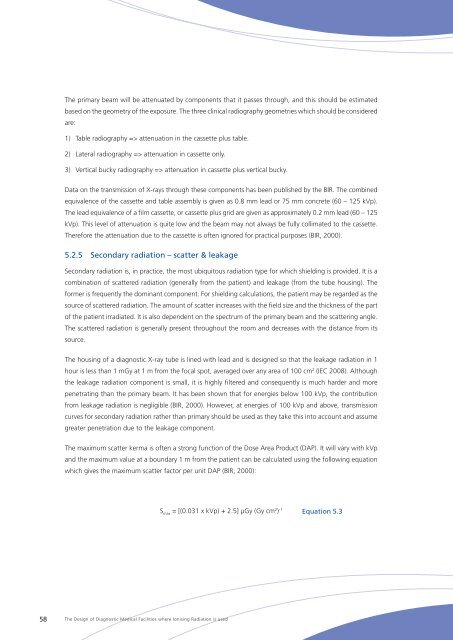The Design of Diagnostic Medical Facilities where ... - ResearchGate
The Design of Diagnostic Medical Facilities where ... - ResearchGate
The Design of Diagnostic Medical Facilities where ... - ResearchGate
Create successful ePaper yourself
Turn your PDF publications into a flip-book with our unique Google optimized e-Paper software.
<strong>The</strong> primary beam will be attenuated by components that it passes through, and this should be estimated<br />
based on the geometry <strong>of</strong> the exposure. <strong>The</strong> three clinical radiography geometries which should be considered<br />
are:<br />
1) Table radiography => attenuation in the cassette plus table.<br />
2) Lateral radiography => attenuation in cassette only.<br />
3) Vertical bucky radiography => attenuation in cassette plus vertical bucky.<br />
Data on the transmission <strong>of</strong> X‐rays through these components has been published by the BIR. <strong>The</strong> combined<br />
equivalence <strong>of</strong> the cassette and table assembly is given as 0.8 mm lead or 75 mm concrete (60 – 125 kVp).<br />
<strong>The</strong> lead equivalence <strong>of</strong> a film cassette, or cassette plus grid are given as approximately 0.2 mm lead (60 – 125<br />
kVp). This level <strong>of</strong> attenuation is quite low and the beam may not always be fully collimated to the cassette.<br />
<strong>The</strong>refore the attenuation due to the cassette is <strong>of</strong>ten ignored for practical purposes (BIR, 2000).<br />
5.2.5 Secondary radiation – scatter & leakage<br />
Secondary radiation is, in practice, the most ubiquitous radiation type for which shielding is provided. It is a<br />
combination <strong>of</strong> scattered radiation (generally from the patient) and leakage (from the tube housing). <strong>The</strong><br />
former is frequently the dominant component. For shielding calculations, the patient may be regarded as the<br />
source <strong>of</strong> scattered radiation. <strong>The</strong> amount <strong>of</strong> scatter increases with the field size and the thickness <strong>of</strong> the part<br />
<strong>of</strong> the patient irradiated. It is also dependent on the spectrum <strong>of</strong> the primary beam and the scattering angle.<br />
<strong>The</strong> scattered radiation is generally present throughout the room and decreases with the distance from its<br />
source.<br />
<strong>The</strong> housing <strong>of</strong> a diagnostic X‐ray tube is lined with lead and is designed so that the leakage radiation in 1<br />
hour is less than 1 mGy at 1 m from the focal spot, averaged over any area <strong>of</strong> 100 cm 2 (IEC 2008). Although<br />
the leakage radiation component is small, it is highly filtered and consequently is much harder and more<br />
penetrating than the primary beam. It has been shown that for energies below 100 kVp, the contribution<br />
from leakage radiation is negligible (BIR, 2000). However, at energies <strong>of</strong> 100 kVp and above, transmission<br />
curves for secondary radiation rather than primary should be used as they take this into account and assume<br />
greater penetration due to the leakage component.<br />
<strong>The</strong> maximum scatter kerma is <strong>of</strong>ten a strong function <strong>of</strong> the Dose Area Product (DAP). It will vary with kVp<br />
and the maximum value at a boundary 1 m from the patient can be calculated using the following equation<br />
which gives the maximum scatter factor per unit DAP (BIR, 2000):<br />
S max<br />
= [(0.031 x kVp) + 2.5] μGy (Gy cm 2 ) -1<br />
Equation 5.3<br />
58<br />
<strong>The</strong> <strong>Design</strong> <strong>of</strong> <strong>Diagnostic</strong> <strong>Medical</strong> <strong>Facilities</strong> <strong>where</strong> Ionising Radiation is used
















